Who doesn’t like butterflies?! Lissome and lithe, their shiny, sparkling, shimmering bodies float from one nectar-filled goblet to the next on gossamer wings, sipping of the sweet life-sustaining syrup. Their habitat ranges from the mountains to the valleys, their sizes and shades cover a wide spectrum, and their metamorphosis from tiny egg to larva (caterpillar) to pupa (chrysalis) to adult is almost too fantastic to believe. While I am one of many butterfly fans, I do not know much about these lovely insects, a shortcoming I hope to remedy.
One person who knows A LOT about these winged wonders is one of America’s foremost lepidopterists and conservationists, Robert Michael Pyle. I first learned about him by happenstance when I came across The Thunder Tree at a bookstore in Moab, Utah, in 2011. A memoir of his childhood in a still-wild suburb of Denver before it ballooned into the behemoth that supplanted vast, vibrant stretches of prairie with dead deserts of concrete, it elaborates on his burgeoning passion for butterflies. His style and passion for nature compelled me to buy Mariposa Road, the story of his Butterfly Big Year, but, alas, my good intentions were sidetracked by lesser pursuits, and his 550 page oeuvre has been staring at me accusingly from the shelf for the last seven years.
To avoid a similar scenario, when I recently noticed an advertisement for his latest publication, I did not waste any time, and devoured Magdalena Mountain, his first novel, in a few days. Set in Colorado and full of alluring descriptions of its high country and denizens, the narrative revolves around the amazing life cycle of the Magdalena Alpine butterfly (Erebia magdalena). Natural history is interspersed and contrasted with an account of the political, religious, and social changes that influenced this state and country, and the author’s affirmation of life and love (sexual descriptions are not limited to butterflies) runs through the suspenseful, lyrical narrative like a common thread. One of many possible conclusions I carried away: Only when we cease to look at life in an anthropocentric way will humankind have a chance to survive, and to leave behind a livable earth.
Inspired, I pulled the National Audubon Society Field Guide to North American Butterflies off the shelf where it had collected dust for even longer than Mariposa Road. My husband’s handwritten dedication indicated that this was a birthday present to me in 1998! It seems impossible that two decades have passed so swiftly, but I was equally as surprised to see that this tome was authored by none other than Robert Michael Pyle. Having come full circle, I finally leafed through its glossy pages and tried to identify some of the Colorado butterflies whose pictures I have taken throughout the years, Magdalena not (yet) among them. If I have erred, please correct me. I look forward to understanding more about these creatures who have been at the center of Mr. Pyle’s life, and long and luminous career.
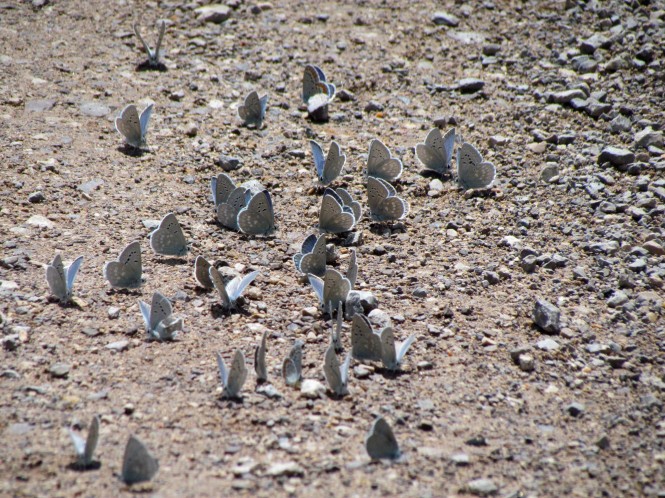
Common Blue (Polyommatus icarus)/Gemeiner Bläuling

Sulfur (Colias ?)/Gelbling

Painted Lady (Vanessa cardui )/Amerikanischer Distelfalter
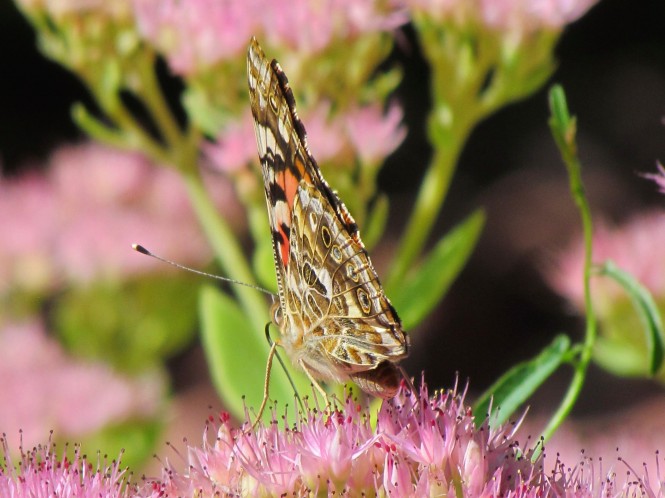
Painted Lady (Vanessa cardui )/Amerikanischer Distelfalter
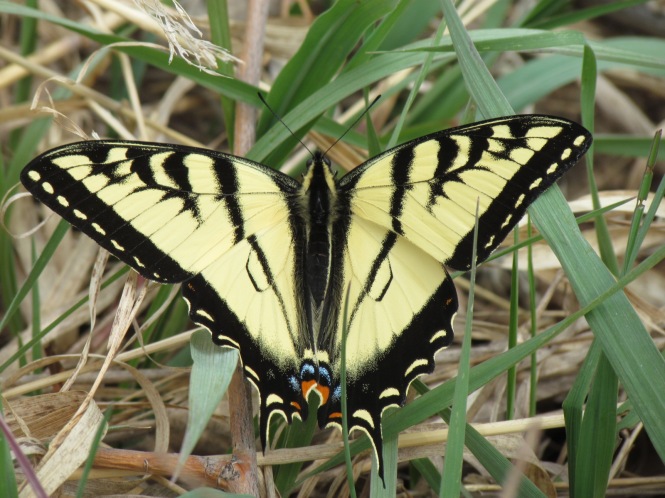
Western Tiger Swallowtail (Papilio rutulus)/Westlicher Tigerschwalbenschwanz

Anise Swallowtail (Papilio zelicaon)/Anis-Schwalbenschwanz

Phoebus Parnassian (Parnassius phoebus)/Alpenapollo

Mourning Cloak (Nymphalis antiopa)/Trauermantel
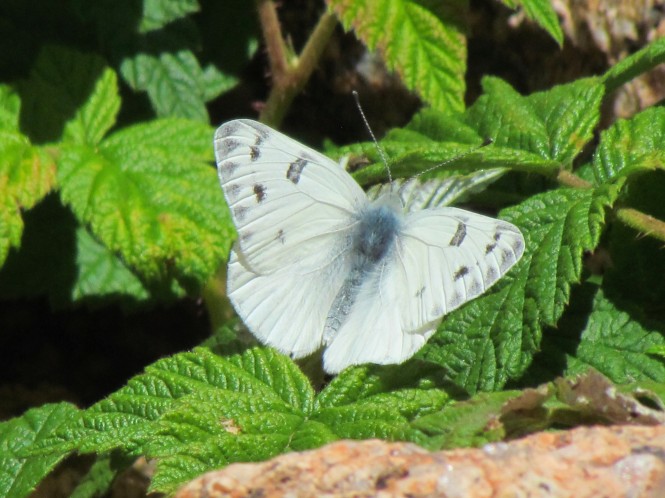
Western White (Pontia occidentalis)/? Westlicher Weißling

Callippe Fritillary, female (Speyeria callippe)/? Perlmutterfalter, weiblich

Callippe Fritillary, male (Speyeria callippe)/? Perlmutterfalter, männlich

Weidemeyer’s Admiral (Limenitis weidermeyerii)/? W. Admiral
Click here for Flying Jewels-Part 1, my post about hummingbirds.
Click here for my post Monarchs and Milkweed, which shows the amazing life cycle of the butterfly shown in the topmost photo, and the many perils it faces.

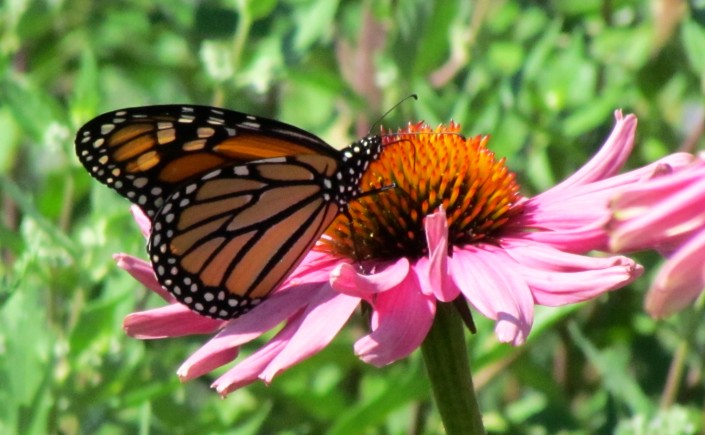


Its lovely to see these butterfly photos and I particularly like the Parnassius phoebus which I don’t remember seeing a photo of before, its wonderfully beautiful!
LikeLiked by 3 people
Thank you, Liz. I also like the Parnassius, the lighting turned out to be advantageous. I hope to learn more about all these amazing creatures. 🦋
LikeLiked by 2 people
Lovely butterflies!
LikeLiked by 2 people
Thank you! 🦋
LikeLiked by 2 people
Morning.
Thanks for this, Tanja. Lovely writing, as ever. I shall search for Mr. RM Pyle. Have you ever looked into V. Nabokov’s butterfly net? He was, beyond being literature’s Picasso, an avid, & studied, lepidopterist.
-Glad to see you back this morning.
http://nautil.us/blog/how-butterfly-genitalia-inspired-nabokovs-masterpieces
LikeLiked by 2 people
Thank you for your comment, Nick, and for the link.
Nabokov features prominently in “Magdalena Mountain”, and Mr. Pyle has co-edited a book “Nabokov’s Butterflies.”
https://en.wikipedia.org/wiki/Nabokov%27s_Butterflies
LikeLiked by 3 people
…One step beyond, as ever, Tanja… I shall endeavour to get up earlier! 🙂
LikeLiked by 1 person
Not at all, Nick. I did not mention Nabokov, and since you had not read Pyle, how would you have known.
And, by the way, since you are several time zones ahead of me, it stands to reason that you rise before me every single day!
LikeLiked by 2 people
…Ha! Now I’m ahead of the game! 🙂
Mr. Pyle has been noted in my little red book.
LikeLiked by 2 people
Ein sehr schöner Beitrag, wie immer! Mir gefällt am besten die zurückhaltende Eleganz von Weidemeyer’s Admiral. Vielleicht lege ich mir mal auch ein Schmetterlingbuch zu 🙂 Liebe Grüße, Andrea
LikeLiked by 3 people
Herzlichen Dank, liebe Andrea. Ich finde den Admiral auch sehr elegant. Leider habe ich noch kein Photo mit geöffneten Flügeln erwischen können, aber ich werde es versuchen.
Falls Du Dir ein Schmetterlingsbuch zulegst, empfehle ich Dir, nicht zwanzig Jahre lang mit dem Durchblättern zu warten! 😊
Liebe Grüße,
Tanja
LikeLiked by 2 people
Ich werde deinem Rat folgen 🙂
Liebe Grüße, Andrea
LikeLiked by 2 people
Sensationell, Tanja.
Besonders die vielen Bläulinge.
Danke für den tollen Beitrag, der dich viel Arbeit gekostet hat.
Man sieht und liest das.
Sehr, sehr schön!
Liebe Grüße, Brigitte
LikeLiked by 4 people
Es hat viel Spaß gemacht, liebe Brigitte, und frau lernt nie aus!
Die Bläulinge suchen auf dem Boden nach Mineralien, wenn ich das recht verstehe. Ich habe sie schon öfter in Gruppen gesehen, und ich beobachte sie immer gerne.
Vielen herzlichen Dank,
Tanja
LikeLiked by 2 people
I see from Wikipedia that “V. cardui is one of the most widespread of all butterflies, found on every continent except Antarctica and South America.” It’s interesting that what English calls a painted lady German calls a thistle butterfly. The species name cardui is Latin for ‘of the thistle.’ I see this butterfly on many kinds of flowers, not just thistles.
LikeLiked by 3 people
As discussed before, a lot of animal names do not make sense, or they are too limited. Very likely the person who first described the Painted Lady saw it feeding on thistle-voilà!
LikeLiked by 2 people
Ich liebe Schmetterlinge! Unglaublich, wie viele tolle du da zusammengestellt hast!
LikeLiked by 3 people
Ich danke Dir herzlich. Mit Schmetterlingen geht es mir so wie mit Blüten und Vögeln. Ich kann nicht an ihnen vorbeilaufen, ohne ein Photo zu machen. 😊
LikeLiked by 2 people
Wonderful post! I think possibly the second fritillary might be the great spangled fritillary, going by the markings. I’m not even sure you have them in your area. Otherwise I think you nailed them all and I’m so impressed by your photos, and the different species you’ve found.
LikeLiked by 2 people
Thank you, Melissa. Doesn’t the Monarch on the Coneflower resemble your painting? At least in my mind it does.
According to my field guide, the Great Spangled Fritillary does not occur here, but then again, it is over 20 years old, and distribution might have changed in the interim.
Thank you for your comment!
LikeLiked by 1 person
Yes, it sure does!
LikeLiked by 2 people
Absolutely love this butterfly entry, especially the photos and discovery of the undisturbed-for-20-years field guide!
LikeLiked by 2 people
Thank you, Jan! The butterfly guide is a sad statement about good intentions gone awry. But better late than never! 🙂
LikeLiked by 1 person
The designs are so precise, concise, symmetrical and amazing. It’s flabbergasting.
LikeLiked by 3 people
Makes one wonder about the designer, doesn’t it, Neil?
Winged greetings,
Tanja
LikeLiked by 2 people
Wonderful variety you captured here well done !!
LikeLiked by 2 people
I appreciate your interest and comment, Bernie. I hope to meet and photograph more of these beautiful jewels.
LikeLiked by 1 person
Nur kurz, das Bett wartet und es ist schon spät, aber ich will noch sagen, traumhaft schöne Bilder hast du da gemacht. Wow! Und was für eine Vielfalt. Und so viele Bläulinge habe ich auch noch nicht auf einmal gesehen. Sehr sehr schön liebe Tanja! Liebe Grüße und Gute Nacht, Almuth
LikeLiked by 2 people
Es freut mich, daß sie Dir gefallen, liebe Almuth. Und ich wünsche Dir eine geruhsame Nacht, sonst bin ich wieder an Deiner Schlaflosigkeit Schuld! 😊
Liebe Grüße,
Tanja
LikeLiked by 2 people
*lach*! Ich sag jetzt nichts dazu 😉 Besser ist das! LG, Almuth
LikeLiked by 2 people
Such beautiful photos of butterflies! Thank you for the post!
LikeLiked by 2 people
Thank you for visiting the post, Valerie. These beauties always stop me in my tracks. 🦋
LikeLiked by 1 person
Tolle Aufnahmen…. ich werde mir diesen Blogeintrag merken und sollte ich auf einen schwer oder gar nicht zu identifizierenden Schmetterling stossen, dann werde ich darauf zurückgreifen!
Viele Grüsse
Christa
LikeLiked by 3 people
Dankeschön, liebe Christa. Ich kann mir vorstellen, daß es bei Euch einige andere Arten gibt, die ich leider noch nicht gesehen habe. Es gibt bestimmt einen Schmetterlingsführer für Eure Gegend, der würde Dir wahrscheinlich eher weiterhelfen.
Herzliche Grüße zurück,
Tanja
LikeLiked by 1 person
Such beautiful pictures! I love butterflies and have a butterfly bush to attract them.
LikeLiked by 2 people
Thank you, Diane, for your comment, and for the butterfly bush, on behalf of these winged wonders. 😊🦋
LikeLiked by 2 people
All gorgeous, but that Western Tiger Swallowtail outshines the others for colour and wing pattern.
A wonderful series of images, Tanja.
LikeLiked by 2 people
Thank you, Vicki. I think it’s so nice that different butterflies appeal to different people. It is hard for me to pick favorites-I love all of them.
Best,
Tanja 🦋
LikeLiked by 1 person
Beautiful images and yes who doesn’t love butterflies!
LikeLiked by 2 people
At least you and I do, but I think you know far more about them! 🙂
Thank you for stopping by and for commenting.
LikeLiked by 2 people
so lovely!
A very beautiful photo…
LikeLiked by 2 people
Mille grazie! 🦋
LikeLiked by 1 person
I love so much Photography, above all… black & white photo.
LikeLiked by 2 people
Beautiful! I remember when butterflies and ladybugs disappeared for years after the spraying of malathion. I am happy they are back. They are one of nature’s beauties.
LikeLiked by 2 people
Thank you very much.
I can’t imagine living without winged wonders, be they bugs, or birds, or butterflies. 🐞🐦🦋
LikeLiked by 1 person
Tanja, your narrative is once again a delightful excursion in English, so beautifully written. ❤
This summer I got a macro les for my full frame camera. I didn't know how hard it is to capture those winged, flimsy wonders! Your gallery is most impressive, well done. Interesting to learn about the connection Nabokov – Pyle, the books are on my list now. 🙂
Wishing you a wonderful Sunday,
The Fab Four of Cley
LikeLiked by 2 people
I am glad you enjoyed my post and photos, and hope you will enjoy Mr. Pyle’s writing.
Best wishes,
Tanja
LikeLiked by 2 people
What joyful captures! Butterflies are one of the few insects people do not find repulsive and I think their variety of stunning wing color has something to do with this. Looking forward to hunting down “Mariposa Road” for a read.
LikeLiked by 2 people
Thank you! I actually think that many people are repulsed not by six-legged insects, but rather by eight-legged creatures. It is hard to find lovers of spiders, ticks, and mites…
I hope you and I both will enjoy “Mariposa Road”.
LikeLiked by 2 people
Tanja – I confess that I know very little about butterflies. I think they are beautiful and enjoy seeing them when out hiking; but, had never given them much thought. Your post has encouraged me to take a closer look at them. Thank you so much for the inspiration! – Jill
LikeLiked by 1 person
That makes me very happy, Jill. My experience has been that I appreciate animals and plants more if I know a little more about them. But, unlike Mr. Pyle, I will never become an expert on butterflies. My bird brain does not have sufficient space for both. 😊🐦🦆🦉
LikeLiked by 1 person
I know what you mean about knowledge making the experience so much more fun. I don’t think I will be an expert either but I will look at butterflies with new eyes.
LikeLiked by 1 person